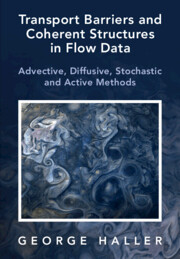 Transport Barriers and Coherent Structures in Flow Data
Transport Barriers and Coherent Structures in Flow Data Book contents
- Frontmatter
- Dedication
- Contents
- Preface
- Acknowledgments
- 1 Introduction
- 2 Eulerian and Lagrangian Fundamentals
- 3 Objectivity of Transport Barriers
- 4 Barriers to Chaotic Advection
- 5 Lagrangian and Objective Eulerian Coherent Structures
- 6 Flow Separation and Attachment Surfaces as Transport Barriers
- 7 Inertial LCSs: Transport Barriers in Finite-Size Particle Motion
- 8 Passive Barriers to Diffusive and Stochastic Transport
- 9 Dynamically Active Barriers to Transport
- Appendix
- References
- Index
9 - Dynamically Active Barriers to Transport
Published online by Cambridge University Press: 20 February 2023
- Frontmatter
- Dedication
- Contents
- Preface
- Acknowledgments
- 1 Introduction
- 2 Eulerian and Lagrangian Fundamentals
- 3 Objectivity of Transport Barriers
- 4 Barriers to Chaotic Advection
- 5 Lagrangian and Objective Eulerian Coherent Structures
- 6 Flow Separation and Attachment Surfaces as Transport Barriers
- 7 Inertial LCSs: Transport Barriers in Finite-Size Particle Motion
- 8 Passive Barriers to Diffusive and Stochastic Transport
- 9 Dynamically Active Barriers to Transport
- Appendix
- References
- Index
Summary
In the preceding chapters, we have discussed definitions and identification techniques for observed material barriers to the transport of fluid particles, inertial particles and passive scalar fields. All these barriers are directly observable in flow visualizations based on their impact on tracers carried by the flow. However, the transport of several important physical quantities, such as the energy, momentum, angular momentum, vorticity and enstrophy, is also broadly studied but allows no direct experimental visualization. These important scalar and vector quantities are dynamically active fields, i.e., functions of the velocity field and its derivatives.We will collectively refer to barriers to the transport of such fieldsas dynamically active transport barriers. This chapter will be devoted to the development ofan objective notion of active barriers in 3D unsteady velocity data. Additionally, 2D velocity fields can also be handled via this approach by treating them as 3D flows with a symmetry.
- Type
- Chapter
- Information
- Transport Barriers and Coherent Structures in Flow DataAdvective, Diffusive, Stochastic and Active Methods, pp. 331 - 366Publisher: Cambridge University PressPrint publication year: 2023
